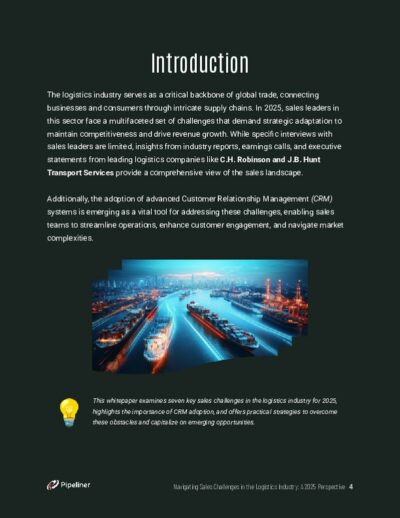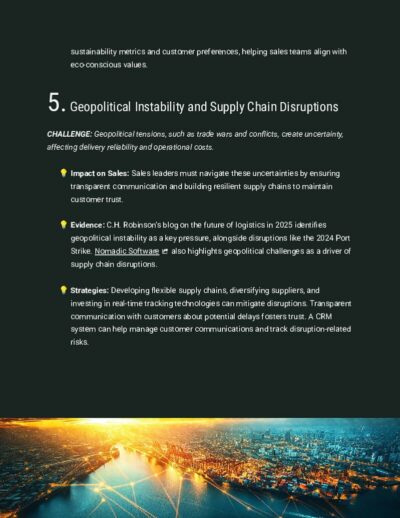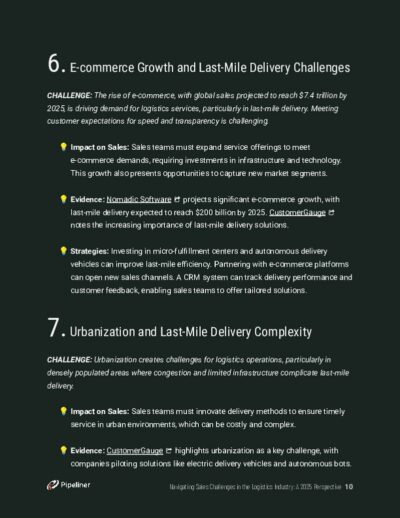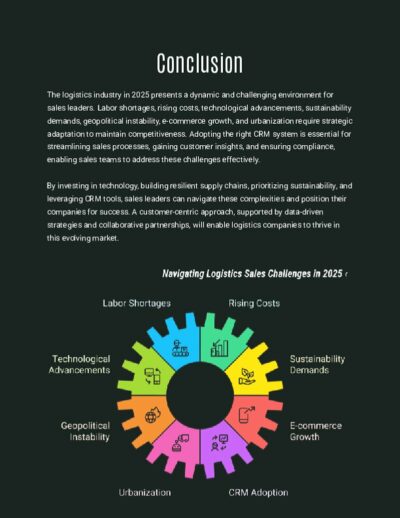
Navigating Sales Challenges in the Logistics Industry: A 2025 Perspective
The logistics industry in 2025 is navigating a dynamic and challenging environment, with sales operationsSales Operations Sales Operations is a collection of aligned business processes, strategic implementations and other activities aimed at achieving organizational goals, specially in the areas of sales revenue, market coverage and growth. facing significant hurdles driven by economic, technological, and societal shifts. Key challenges include labor shortages, rising operational costs, rapid technological advancements, sustainability pressures, geopolitical and supply chain disruptions, e-commerceE-Commerce E-Commerce is a field, platform, or environment where the buying and selling of goods and services are transacted online. growth, and urbanization complexities. These issues impact sales teams by complicating pricing strategies, straining service reliability, and requiring new skills to meet evolving customerCustomer Customer is an individual or an organization that purchases a product or signs up for a service offered by a business. expectations.
The whitepaper, “Navigating Sales Challenges in the Logistics Industry: A 2025 Perspective,” examines the dynamic and challenging environment facing sales operations in the logistics sector in 2025. It explores seven key hurdles driven by economic, technological, and societal shifts, such as labor shortages, rising costs, technological advancements, sustainability pressures, geopolitical instability, e-commerce growth, and urbanization complexities. The document highlights how these issues impact sales teams, complicating pricing, straining service reliability, and requiring new skills. A key focus is the importance of adopting the right Customer Relationship Management (CRM) system to streamline sales processes, enhance customer relationships, and maintain competitiveness. The whitepaper draws insights from industry reports, earnings calls, and executive statements to provide actionable strategies for sales leaders to adapt and succeed.
Sales Challenges and Strategies Descriptions
Here are the key sales challenges for 2025 and the strategies discussed:
1. Labor Shortages and Talent Retention
- Challenge Description: A significant shortage of skilled workers continues to disrupt supply chain efficiency, resulting in delays and reduced service quality that can erode customer trust and leadLead Lead refers to a prospect or potential customer (who can be an individual or organization) that exhibits interest in your service or product; or any additional information about such entity. to lost sales.
- Strategies: Sales leaders can invest in training programs, offer competitive compensationCompensation Compensation is the total payment and benefits an employee receives for rendering work — covering basic salary, allowances, commissions, bonuses, health insurance, pension plans, paid leaves, stock options, and other benefits., adopt automation technologies such as robotic warehousing, and utilize a CRM system to track customer concerns and streamline communication.
2. Rising Costs and Economic Pressures
- Challenge Description: Escalating operational costs, particularly for fuel and transportation, alongside inflation and competitive pressures, make competitive pricing difficult without sacrificing profitabilityProfitability Profitability is the potential, degree, metric, ability or relative efficiency of a business to yield financial gain (i.e., profits) after all relevant expenses and costs have been deducted..
- Strategies include leveraging AI-driven route optimizationOptimization Optimization is the process or act of altering a system, design, or procedure such that it 1) attains full functionality or efficiency, or 2) generates maximum output, benefit, or impact., negotiating cost-effective supplier contracts, diversifying service offerings (such as value-added warehousing), and utilizing a CRM system to track pricing trends and tailor offers.
3. Technological Transformation and Automation
- Challenge Description: The rapid adoption of technologies like AI and automation is reshaping logistics, requiring sales teams to adapt. This adaptation involves significant investment and training to leverage these tools and demonstrate their value to customers.
- Strategies: Sales teams can partner with technology providers, invest in employee training, highlight the benefits of technology (such as improved efficiency and reliability), and integrate a CRM system with logistics technologies to achieve real-time dataData Data is a set of quantitative and qualitative facts that can be used as reference or inputs for computations, analyses, descriptions, predictions, reasoning and planning. and data-driven solutions.
4. Sustainability as a Competitive Differentiator
- Challenge Description: Growing regulatory and consumer pressures mean customers increasingly factor eco-friendly practices into their decision-making, requiring sales teams to integrate sustainable options into their offerings or risk losing business.
- Strategies: Implementing practices such as route optimization and the use of electric vehicles, effectively communicating these efforts to customers, and utilizing a CRM system to track sustainability metricsMetrics Metrics are quantities that are measured and used to: and customer preferences can enhance appeal.
5. Geopolitical Instability and Supply Chain Disruptions
- Challenge Description: Geopolitical tensions and conflicts create uncertainty that affects delivery reliability, operational costs, and requires sales leaders to ensure transparent communication and build resilient supply chains.
- Strategies: Developing flexible supply chains, diversifying suppliers, investing in real-time tracking technologies, and using a CRM system to manage customer communications and track disruption risks are key strategies.
6. E-commerce Growth and Last-Mile Delivery Challenges
- Challenge Description: The significant growth of e-commerce drives high demand for last-mile delivery services, which challenges logistics providers to meet customer expectations for speed and transparency. This requires investment in infrastructure and technology.
- Strategies: Investing in micro-fulfillment centers and autonomous delivery vehicles can improve efficiency. Partnering with e-commerce platforms can open new sales channels, and implementing a CRM system can track delivery performance and customer feedback.
7. Urbanization and Last-Mile Delivery Complexity
- Challenge Description: The increasing urbanization of densely populated areas complicates last-mile delivery due to congestion and limited infrastructure, making timely service both costly and complex.
- Strategies: Adopting innovative solutions, such as drone deliveries and optimized routing algorithms, collaborating with local governments, and utilizing a CRM system to manage urban delivery logistics and customer expectations can help address these issues.
Learn More About Pipeliner CRM
Take a no-obligation 14 day trial of Pipeliner CRM.
No credit card info required – just experience for yourself how it could impact your sales.
Additional Resources
This ebook is on the subject of “Win Together.” It falls under the same context as“win-to-win” described in my book Network Selling: Guarantee Success for the Digital Age. Today, this aspect of sales is more important than ever, and must also be part and parcel of CRM solutions.
“For some years I’ve been saying that, as a society, we’re in the midst of a transformation. Given what’s happened in the last couple of years, there’s no one left who is disagreeing with me! It’s become very obvious.”
 Nikolaus Kimla, CEO at Pipelinersales, Inc.
Nikolaus Kimla, CEO at Pipelinersales, Inc.A common term in sales today is EQ, which stands for “emotional I.Q.” It means the skill a salesperson has in reading emotions and utilizing them in sales. It means empathy and a number of other abilities. The short version is, it’s an I.Q. when it comes to emotions. But just as with our Network Selling model, E.Q. isn’t just for sales, either. It’s actually the missing factor in human interactions, for confrontation—a common “tool” in human interactions—doesn’t actually handle anything.
“You can have everything in life you want if you will just help enough other people get what they want.”
 Zig Ziglar
Zig Ziglar






